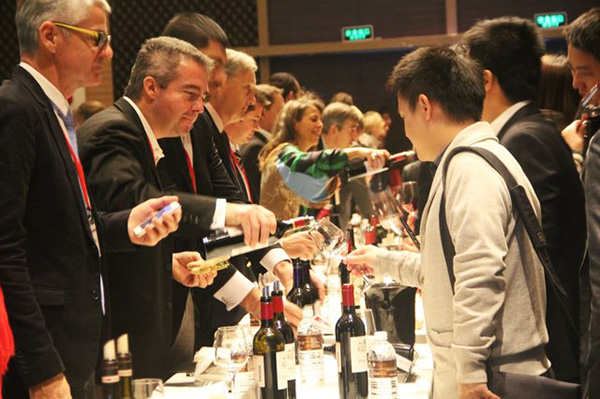
Vintners must invest resources to educate consumers about what quality wines are
At the four-day 49th Vinitaly, the world's largest wine trade expo, in Verona, Italy, more than 4,000 exhibitors and 150,000 wine industry professionals eagerly sought out business opportunities and potential partners.
Unlike previous years, for the event in March organizers introduced a series of initiatives targeting the Chinese market, such as inviting more Chinese wine professionals to study at the Vinitaly International Academy, arranging special seminars and promotions, setting up a marketing team in Shanghai, and opening accounts on Sina Weibo and WeChat, two Chinese social networking services.
Vinitaly organizers have also helped more than 100 Italian wineries participate in the China Food and Drinks Fair, held every spring in Chengdu, Sichuan province.
More winemakers are realizing the importance of the Chinese market. Some visionary vintners have already started investing resources to promote their brands in China, but most are only at the ideas stage.

Sales in the Italian domestic market have slipped, although the global market has seen no significant decline, which means the pressure is not so great for large wine companies. However, small wineries, which are feeling the pressure and are paying more attention to the Chinese market, lack the resources to promote in China. They hope to have more opportunities to be discovered by Chinese importers or find venues to reach as many Chinese customers as they can.
No matter the size of the winery, the common attitude is to welcome Chinese importers to buy alcohol, and after the money comes in, make a shipment. What happens after delivery is up to importers. The mentality is, "Our wine is so good, consumers will know it in the long run." This mentality is not unique to Italy; all European wine producers have it, including in major wine-producing countries of France, Spain and Germany.
The average import price of European wines is lower than that of the New World wines, and their long-term development in the Chinese market is not encouraging.
According to China's official customs data, although France was China's biggest wine exporter last year - 129.5 million liters, worth $660.6 million (590.8 million euros) - it was closely followed by Australia (40.8 million liters) and Chile (90.8 million liters), two New World wine countries, and Spain (49.5 million liters) and Italy (25.3 million liters). European wines are cheaper to buy in China than New World wines. French wine costs on average $5.11 per liter; Australian wine, $6.27; Spanish, $2.22; Italian, $4.11; wine from the United States, $4.40; and New Zealand wine, $12.
We could read three things from these figures. First, the overall quality of European wines in China is lower than that of New World wines. Second, the average premium of European wine brands is also lower, as New World wines have made much more investment and done more promotion in China. Third, the market awareness of European vintners is weaker.
Due to the lack of market research in China, a large number of low-quality European wine products have flooded the Chinese market. This shows European vintners have little say as to what kind of wine should be sold in China. The right to decide is in the hands of Chinese importers and distributors.
Why are traditional European wine-producing countries selling low-quality products in China? Because European winemakers have not really paid enough attention to the market, and there is no real investment or resources to develop the Chinese market.
At Vinitaly, many European vintners talked about their success in the US, and say China is like the US in the 1960s and 1970s. They think they just need to wait for the market to mature and then can enjoy the fruits of victory. Yet while they may see the huge potential demand in China, they are turning a blind eye to the essential difference between the Chinese and US markets.
Due to differences in language and culture, they need to put more energy and resources in wine education and training in China, but no one is willing to serve as educator. The US is an English-speaking country and most residents are European immigrants. The Chinese language and culture are completely different, more than 90 percent of consumers not understanding a European language.
The rise of US wine producers has also enhanced the popularity of wine, as they serve as the primary educators of this market. As local vintners have educated and trained consumers, the demand for European wine demand has improved.
However, in China, local wine producers are more predator than educator, flooding the market with low-quality products. Many strong dealers have followed the thinking of local wine merchants, importing low-quality wine to sustain this predatory business behavior, ironically from France and Spain, which should be providing high quality.
Low-quality wine will definitely not cultivate wine consumers in China. European winemakers must educate Chinese consumers. The strategy of "picking the fruit, not planting trees" may have been effective in the US, but in China it will fail. The Chinese market presents dozens of historical differences from the US market, while competitors from the New World are not weak like they were decades ago.
Chinese consumers appreciate wine culture, but their interest has been slow in driving up purchasing power.
First, most consumers cannot tell a wine's quality. They urgently need to be educated, and European vintners have done very little to improve this. A wine lover once asked: "Old World wines are rarely made of a single grape, is this because their grapes are of inferior quality to New World wines and need to compensate by blending different grapes?" With such misleading information out there, there needs to be a response from European winemakers.
Second, Chinese importers and distributors need educating. A large number of them do not really know how to distinguish wine quality. In addition to market-driven needs and interests, they might believe there is little difference between high-quality and low-quality wine, and they also know that consumers lack this ability.
Third, imported bottled wine is still too expensive in China. One bottle costs 5 euros ($5.50) in Europe, but 25 euros in China. The price difference is partly because of freight and tariff factors, but the main reason is that European wine producers are reluctant to invest in this market.
Since Chinese importers often have to bear the risks and marketing expenses, they raise prices to cover their costs. If vintners were willing to support their Chinese partners and help them avoid some of the risks, we could have a win-win situation.
In business, any single-win cooperation model won't last long. To ensure sustainable development, it needs to be win-win.
Jeff Gong is director of Beijing VOGUEAD Brand Marketing Inc, a Beijing-based brand consultancy, and Rebecca Wang is marketing director. The views do not necessarily reflect those of China Daily.
Contact the writer at voguead@163.com
(China Daily European Weekly 07/24/2015 page12)
